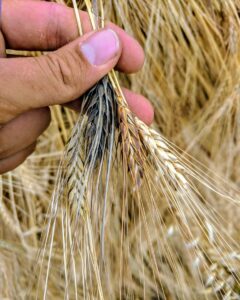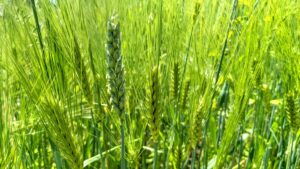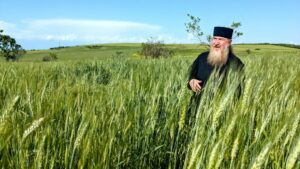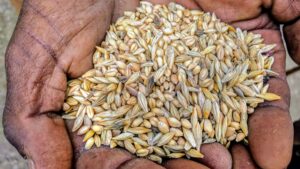Ancient Farming Strategy Holds Promise for Climate Resilience
“Duragna” is a mix of wheat and barley, and sometimes other grains too, planted together rather than one type of grain sown in orderly rows.
Morgan Ruelle, M.S. ’10, Ph.D. ’15, was living in the remote mountains of Ethiopia in 2011, researching his dissertation on food diversity, when he kept hearing about a crop that confused him.
The farmers repeatedly mentioned a grain called “duragna” in Amharic that had no equivalent in English. “They kept saying, ‘Well, it’s not really wheat, it’s not really barley,’” Ruelle says. “I was just kind of stumped by it for several weeks.”
Eventually a farmer explained that duragna was actually a mix of both wheat and barley, and sometimes other grains too, planted together, rather than one type of grain sown in orderly rows.

A farmer holds multiple varieties of wheat and barley from his field in Kutabir District, Amhara, Ethiopia. Alex McAlvay / New York Botanical Garden
He had stumbled upon one of the few places in the world where farmers still sow maslins, or cereal species mixtures, which can contain rice, millet, wheat, rye, barley, triticale, emmer and more.
The knowledge the farmers shared with Ruelle led to a paper by current and former Cornell researchers that suggests maslins, which have fed humans for millennia but now are largely forgotten, have the unique capacity to adapt in real time to increasingly unpredictable and extreme weather caused by climate change.
The research, funded by a grant from the Cornell Atkinson Center for Sustainability, braids together previous work in agronomy, ethnography, archeology, history and ecology. It shows maslins – from a Latin word for “mixed” – have been used for more than 3,000 years and in at least 27 countries, from northern Africa to Europe and Asia and later North America. Wild maslins may have even given rise to agriculture.
“Subsistence farmers around the world have been managing and mitigating risk on their farms for thousands and thousands of years and have developed these locally adapted strategies to do that,” says former Cornell postdoctoral researcher Alex McAlvay, the paper’s first author and now a researcher at the New York Botanical Garden. “There’s a lot we could learn from them, especially now, in a time of climate change.”
More rapid than evolution
At first, Ruelle – now an assistant professor of environmental science and policy at Clark University – thought farmers were growing maslins together, and then separating the components during the harvest – easy enough with other mixed plantings like fava beans, which grow tall, and low-growing field peas. But wheat and barley? “I couldn’t imagine them going through the field and saying, this is wheat, this is barley. That just seemed very difficult.”

Mixed grains grow in the Republic of Georgia. Researchers on the project say Georgia is arguably the center of wheat diversity; at least 12 different types of mixtures were traditionally grown in the country until recently. Alex McAlvay / New York Botanical Garden
Then he began to realize why farmers think of the mixture as a single crop. Women began telling him they use it to make bread, beer, injera – a sourdough pancake – and kollo, a popular snack of roasted cereals, legumes and oilseeds. The wheat and barley are planted together, harvested together, prepared and consumed together.
“Right away we were thinking, the proportions [of wheat and barley] must change year to year,” Ruelle says. “It’s this continuously evolving responsive entity. On its own, it’s operating outside the farmer’s control to respond to whatever conditions happen.”
For example, if an unusually heavy rain destroys half the plants, the plants that are still standing are well adapted to that rain event, says Anna DiPaola, a doctoral student and a co-author of the paper. “Nature is giving the farmer feedback and saying, ‘This is well-adapted. Plant this again.’”
And if a drought makes it a bad year for wheat, barley, which tends to be more drought resistant, will compensate and produce a better yield, Ruelle says. “So no matter what, you’re going to be able to make bread with this.”

Nikoloz Lomsadze, senior pastor of a church in Dedoflis Tskaro, in eastern Republic of Georgia, looks over his field of mixed barley and wheat. He uses the grain mixture for holy sacraments and church feasts. Alex McAlvay / New York Botanical Garden
McAlvay found farmers extoling that benefit during research in the country of Georgia. On their first field trip there, in summer 2022, he talked with a priest who was growing a mixture of wheat and barley, which he uses for holy sacraments and church feasts. “He said, ‘If one fails, at least we have the other.’ The translator used the exact same words that the translator in Ethiopia had used. I thought, ‘Wow, this is a phenomenon,’” McAlvay says.
The proportions in the mixtures shift from year to year, automatically adapting to the growing conditions at hand. If an area is getting increasingly drier, the wheat won’t grow as well, and the seed the farmer saves for the next planting will automatically include less wheat and more barley, McAlvay says.
“It’s more rapid than evolution. If you had just one weak variety, it would take a long time to adapt,” he says. “But if you have multiple species and multiple varieties, those shifts can happen very rapidly.”
That capacity makes maslins a perfect strategy for dealing with climate change – especially because they are more immediately scalable in a way that other polycultures aren’t. New machinery would be needed to harvest beans and corn grown together. “But we’ve had the technology to harvest these grains for a long time,” McAlvay says.
Moreover, researchers have been encouraging farmers to adapt to future average conditions, whether warmer or drier, Ruelle says. “But I’m much more worried about variability in the weather increasing, and farmers having to deal with a really hot year followed by a really cool year or a late season followed by an early season,” he says. “I hear farmers in Ethiopia saying, I don’t know what to do – the weather is so unpredictable now.”
Maslins could help farmers thrive in a wider range of conditions, he says. “We’re raising awareness about an Indigenous system that helps farmers deal with variability.”
An ancient strategy
Despite having once been so widespread, the strategy of sowing maslins has flown under the radar, says disease ecologist and agroecologist Alison Power, a co-author of the paper and a professor of ecology and evolutionary biology, and science and technology studies, in the College of Arts and Sciences. Ruelle and McAlvay were postdocs in her lab.
Power hadn’t encountered the concept until she read Ruelle’s dissertation as an adviser on his committee, even though she had been working in the field since the early 1980s. “I said, ‘They do what?’” Power recalls. “The most surprising thing to me was that it goes back so far and that it’s such a widespread practice that continues to this day in several parts of the world,” she says. “Most of us in the agroecology community – this was not something we were aware of.”
She credits Zemede Asfaw, a professor of ethnobotany at Addis Ababa University, with helping the Cornell team and others understand the practice.
Although maslins may not be well known now, they may have grown together in the wild and formed the basis of farming in the Fertile Crescent, the researchers say. There’s evidence that before domestication of these crops, people were planting mixtures of the wild versions, McAlvay says. Wild einkorn and wild emmer grow together, as do wild barley, wild rye and wild oats. “I’ve talked to some Israeli scientists who said that they never find wild wheat without wild barley,” McAlvay says. “These grains have been co-evolving for many, many thousands of years.”

A farmer in Ambasel District, Amhara, Ethiopia holds a mixture of wheat and barley varieties harvested from his field. Locally, this mixture is called “megamegu.” Alex McAlvay / New York Botanical Garden
In addition to human food, maslins have been widely used for livestock fodder; barley-oat, oat-rye and oat-wheat mixtures were planted in North America at least until 1889.
Maslins started falling out of favor starting in the 18th century – not because they didn’t work, but because of mechanization of harvesting equipment as well as scientific agriculture that encouraged farmers to plant one uniform type of cereal to produce a uniform product for the industrialized food industry.
But the practice continues today in Eritrea, India, Georgia, Greece and Ethiopia. In Sudan, farmers grow a mix of rice and sorghum in areas that flood predictably; rice grows in flooded zones and sorghum grows under drier conditions.
In addition to its climate-adaptation benefits, maslins can produce greater and more stable yields, are more tolerant of drought, and better resist pests and weeds, when compared to single crops.
That’s because multiple types of plants respond differently to stressful conditions. The plants’ different characteristics, such as height and root depth, and different ecological roles mean the plants grow complementarily, rather than in competition, and use light and below-ground resources more efficiently compared to single crops.
A mix of Eritrean wheat and barley outperformed sole-cropped wheat and barley by 20% and 11% respectively and yielded a higher quantity of flour per unit compared to pure barley in a field trial. Power says many questions about maslins remain. Do maslins provide better nutrition than monocultures? Could maslin components be used to track environmental trends? How do ecological mechanisms underpin maslins’ performance?
“What we’d like to do is experiments, to test the notion that these could be useful in all the ways that we propose in the paper,” Power says.
Fieldwork in Ethiopia was put on hold due to the COVID-19 pandemic and political conflict there.
So the team began testing their theories closer to home – at Cornell’s Thompson Vegetable Research Farm, in Freeville, New York.
Praying for aphids
Anna DiPaola pops open her laptop computer and fires up a PowerPoint presentation that will become the first chapter of her doctoral dissertation. She launches a slide deck showing 66 orderly test plots measuring 2 meters by 2 meters, in which she’s growing different varieties and combinations of barley and wheat on the test farm in Freeville. “I wanted to plant North American seeds in a North American field and see if the concept holds up here,” she says.
As a member of Power’s lab, she’s testing whether different combinations of wheat and barley will be more resistant to barley yellow dwarf virus, which affects the economically important crops barley, oats, wheat, maize, triticale and rice. The virus can yellow the plant’s leaves, stunt the roots, delay seed development, reduce yield and increase the plant’s susceptibility to fungi.
Aphids carry the virus and transmit it to the plants when they eat the plants’ sap. “Most farmers are not hoping for aphids to attack their crops,” DiPaola says. “I was praying for aphids.”
Insights from her work will contribute to the team’s upcoming research in Georgia and Ethiopia.
The goal will be to ask farmers how and why they plant maslins, to collect seeds and to test hypotheses. And they’ll do nutritional analyses to understand whether micronutrients could be lost by planting monocultures.
“This is a huge portion of the diet for many people,” McAlvay says. “So if you’re not planting the black barley, the red wheat, and just growing white wheat, are you suddenly missing iron or some of these other compounds? There’s a big problem in Ethiopia already, with the hidden hunger issue of micronutrient deficiency.”
And they’re looking into whether maslins could offer even more benefits related to climate change.
Compared with monocultures, maslins may produce more biomass – and take up more carbon than monocultures – because they tap into different nutrients and levels in the soil.
“What’s exciting to me is wheat is the third-most grown crop in the world, millions of hectares,” McAlvay says. “If you converted a large swath of what is just wheat into wheat and barley, you could actually make a difference.”
This article originally appeared in the Cornell Chronicle.

